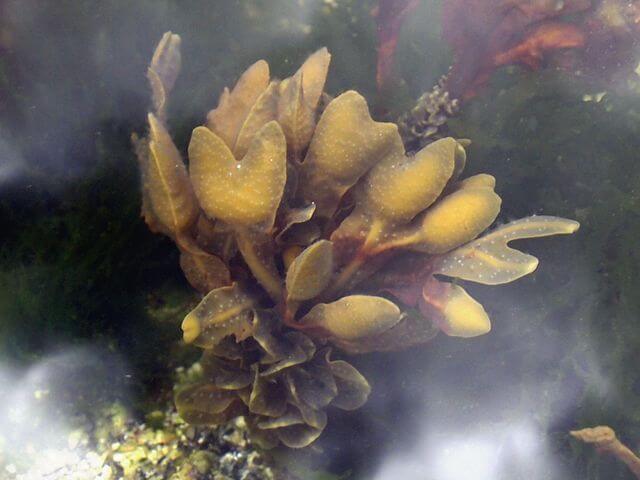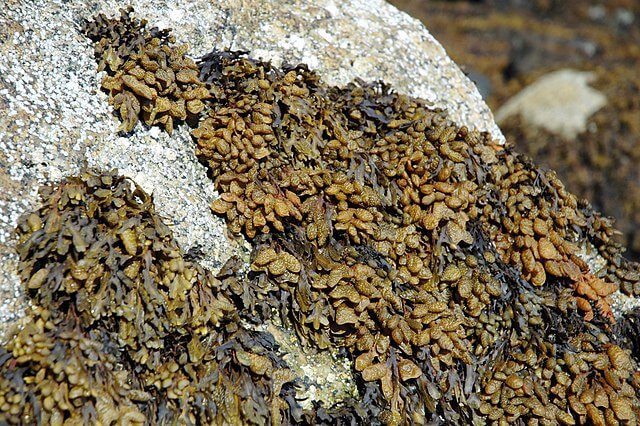Fucus spiralis, aka Spiral Wrack or Twisted Wrack, is brown alga belonging to the Fucaceae family. As a member of this powerhouse family, it is a prized and plentiful plant for coastal foragers. Spiral wrack is native to the Atlantic shores of the UK, as well as the northeastern shores of North America. This wrack grows on rocky substrate in the shallowest of waters, often leaving it exposed to air for long periods of time. Because of spiral wrack’s preferred shallow depths, it has developed the ability to curl its fronds and dry out—reducing its exposed surface area—and cover itself in mucus to survive outside of ocean waters.
Brown with a green hue, spiral wrack is a relatively short alga, with its fronds reaching less than a foot and a half in length. Foragers will find this alga growing in bushy clumps. Spiral wrack gets its name because its flat fronds grow in a spiral shape, though this is not always immediately evident underwater. This seaweed is characterized by a prominent midrib growing vertically along its fronds, leading to a plethora of gel-filled sacs. Unlike many Fucus species, spiral wrack’s bumpy sacs only grow on the tips of its fronds and are often found conjoined into a heart shape. Traditional harvest time lasts from May through December, making it available most of the year.

Edibility and Culinary Use
The sacs of spiral wrack are its reproductive organs, but they’re also its most desirable treat. Often compared to an olive, the gel-filled sacs are salty and share a similar texture. They are enjoyed pickled or fresh and make a great addition to salads. Many cocktail connoisseurs substitute the pickled sacs for olives in martinis, making this relatively easily foraged plant a sophisticated snack. It is recommended to forage for the smaller, younger sacs for better flavor and texture. Spiral wrack’s fronds are usually enjoyed dried and powdered as a gelatinous thickener for soups, stews, or even baking.
Medicinal Properties of Spiral Wrack
Like other wracks, spiral wrack is high in fiber and contains multiple vitamins. It is rich in antioxidant compounds, specifically the prized phlorotannin, which is currently undergoing studies by scientists and medical professionals. Interestingly, phlorotannin plays an important role in spiral wrack’s survival, as herbivores have been shown to avoid algae with high concentrations of this compound. There are hopes that this super antioxidant can be used for many health benefits, but scientists are having trouble extracting its pure form from the alga. Traditionally, Native Americans have used the gel-filled sacs as a salve for burns and minor cuts, much like the modern use of Aloe vera.

Cautions
In recent years, Fucus guiryi, or Guiry’s Wrack, has been labelled as its own species. Previously considered to be Fucus spiralis, Guiry’s Wrack is virtually indistinguishable from spiral wrack and shares the same edible properties. Still, every forager must be confident in proper identification before ingesting a wild plant. As when foraging all shallow seaweeds, steer clear of chemically contaminated waters near cities or drains. To ensure sustainable foraging, only take pieces of spiral wrack, cutting the fronds so that the alga may regrow and replenish itself.
Conclusion
If you’ve ever attempted to consume a fresh olive (don’t), you’ll appreciate the pre-brined sacs of spiral wrack that can be pulled straight from the sea. Like other Wracks, this alga is delicious, readily available, and filled with health benefitting vitamins. It can be found in the cooler waters of northern Atlantic coastlines and grows in such shallow waters that it’s often found on dry land during low tide. On your next beach stroll, keep an eye out for this salty delicacy. Maybe, you’ll end up making a high-end martini once you get home.
Many of our readers find that subscribing to Eat The Planet is the best way to make sure they don't miss any of our valuable information about wild edibles.
See our privacy policy for more information about ads on this site






